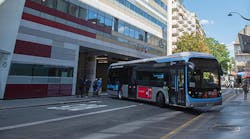STM releases 2025 budget, 2025-2034 capital expenditure
The Société de transport de Montréal (STM) has released its 2025 budget, which totals C$1.8 billion (US$1.3 billion), as well as its 2025–2034 capital expenditure, which details investment needs of C$25.8 (US$18.3 billion), with C$10.7 billion (US$7.6 billion) earmarked for métro asset maintenance so STM can continue to offer safe, reliable services and extend the lifespan of its infrastructure and equipment, especially in the métro network.
Back to a balanced budget in 2025
“I would like to commend all public transit stakeholders, who, in recent months, have worked tirelessly to address the funding challenges. Solutions involved a greater municipal contribution, the 2025 financial framework signed with the Quebec government and the increase in the motor vehicle registration levy by the CMM,” said STM CEO Marie-Claude Léonard. “These measures, together with our significant spending cuts, have allowed us to maintain our current level of service. That being said, we are far from our ideal scenario of expanding our services to make public transit even more appealing.”
Highlights of the 2025 budget include:
A balanced budget
The STM says it has committed to capping its growth in spending to three percent annually for five years, starting in 2026. This has already been achieved for 2025, with a spending increase of 0.2 percent compared to the 2024 figure.
In addition, for the first time since the COVID-19 pandemic, the STM closed its fiscal year without a revenue shortfall to be made up in the coming year, meaning a balanced budget in 2025.
STM notes the budget increase is primarily the result of a concerted effort to improve passengers’ sense of safety in the métro by hiring security employees and maintenance employees. Another C$5 million (US$3.6 million) was allocated to the maintenance of AZUR cars to ensure their long-term viability.
Continued optimization
In 2023, the STM committed to reducing recurring expenses by C$100 million (US$71 million) during the next five years without impacting service levels. Of this target, a total of C$36 million (US$25.6 million) in savings has already been achieved. The STM will pursue its commitment by generating an additional C$16 million (US$11.4 million) in recurring expense reductions in 2025.
Same service offering
STM says it will cover just as many miles in 2025 as in 2024. However, with ridership currently at some 1.1 million trips per workday, STM notes it wants to go further and increase its service offering to maintain the appeal of public transit and meet growing customer demand.
2025–2034 capital expenditure program prioritizes asset maintenance
“Asset maintenance remains the most pressing need detailed in the capital expenditure program. Keeping our existing infrastructure safe and in good working order should be considered a precondition for any further development of the public transit network,” said STM Board of Directors Chair Éric Alan Caldwell. “Of the C$10.7 billion (US$7.6 billion) in investments required, only C$800 million (US$568.3 million) is currently included in the Québec Infrastructure Plan (QIP). This is critical since implementation depends on investments being [included]under the QIP.”
STM notes the shortfall in investments earmarked for métro asset maintenance is already close to C$6 billion (US$4.3 billion). Indexed investments of C$560 million (US$397.8 million) for métro infrastructure alone are needed to keep the deficit from growing. STM says that sum does not include the money needed for rolling stock, related infrastructure and the surface network.
Here are additional highlights from the capital expenditure program in terms of investments needed:
- C$7.2 billion (US$5.1 billion) for the Blue line extension
- C$10.7 billion (US$7.6 billion) for asset maintenance, with C$3.5 billion (US$2.5 billion) to start replacing MR-73 cars and related infrastructure
- C$1 billion (US$710.3 million) for universal accessibility projects
- C$5 billion (US$3.6 billion) for electrifying the bus network
“Important decisions need to be made soon to make sure the métro can continue to take Quebecers where they need to go and help the province’s economy thrive. We are in active discussions with our funders to find sustainable solutions. The goal is to rebalance available funding over time, prioritize the most critical asset maintenance projects and continue to advance other important initiatives, including the electrification of our bus network,” Caldwell said.




